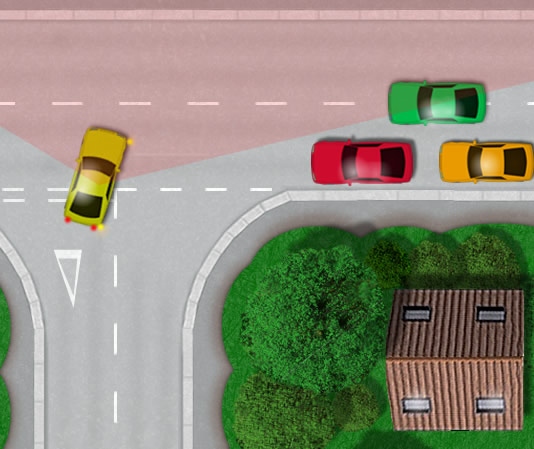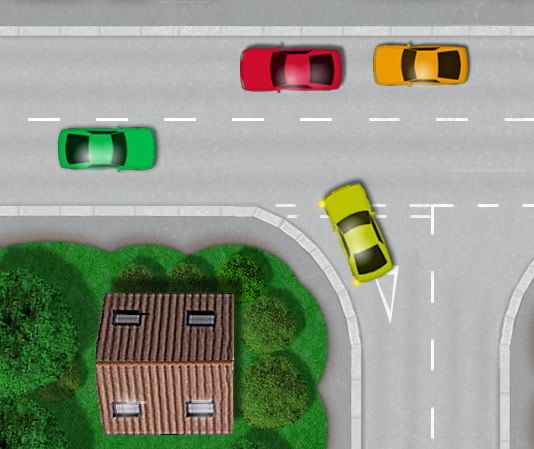Many parts of The Highway Code simply advise motorists on safe motoring procedures to adhere to, and is not necessarily illegal to infringe on such advice.
Parking near junctions (Rule 243) being one piece of advice stating: ‘DO NOT stop or park opposite or within 10 metres (32 feet) of a junction, except in an authorised parking space’. Almost all of us have parked within 10 metres of a junction at some point and as can be seen by observing car parking habits around us, many people park too close on a daily basis.
If it’s not illegal, can I still get a ticket?
Although there’s not a law that specifically prohibits motorists from parking close to a junction, you may still find your vehicle ticketed on your return. A non-endorsable (no penalty points added to your driving licence) Fixed Penalty Notice (FPN) under the offence of unnecessary obstruction will see you fined £50, or up to £100 for more serious circumstances.
I’ve been parking here for a long time, why do I get a ticket now?
You may find that you have parked in the same or similar location for some time, but have only now received a ticket. Police Community Support Officers (PCSOs) patrol designated routes. The area you park may be an infrequent part of the route hence the amount of time it took to receive a ticket. Areas that receive greater tickets issued are due to residents making complaints.
For example, neighbourhoods close to hospitals where drivers attempt to avoid paying for parking by using roads close to hospitals. although not illegal in itself, can cause annoyance for local residence due to a lack of parking on their own roads, parking over driveways and dropped kerbs. PCSO’s will have their routes temporarily altered to such areas in an attempt to restrict those who park inconsiderately.

So why is it illegal to park close to a junction?
As seen in the image above, the yellow vehicle is attempting to turn right out of the junction. The green car is obscured from the yellow cars view by the two vehicles that are parked too close to the junction. The red shaded area illustrates the drivers view of the road, by which time they are some distance into the road.
Other instances where it can prove dangerous to park close to a junction are for pedestrians crossing the road. Junctions are typically crossing areas for pedestrians. Children, wheelchair users and the elderly are particularly vulnerable when attempting to cross due to vehicles being obscured that may be turning into the junction. You must also consider unhindered access for the emergency services.
Other potential issues to consider are located at small and narrow residential streets where larger vehicles need access for deliveries. It’s not uncommon for vehicle owners to discover damage on a corner of their vehicle that’s parked close to a junction, often due to a larger vehicle having inadequate space to manoeuvre.
Parking opposite a junction
Another danger associated with parking too close to a junction is opposite one. The diagram to the right illustrates the yellow vehicle turning left out of the junction. Their main observations will be initially to the right as this is the direction of oncoming traffic. Observation to the left may be too late to take into account of the green car overtaking the cars parked opposite the junction.

Should I challenge a ticket in court?
Even if you were not parked in prohibited area such as on double or single yellow lines, it’s possible you were causing an obstruction and potential hazard for other road users and pedestrians.
If you received a ticket for parking too close to a junction, the PCSO will usually accumulate some form of evidence such as distance from the junction and photographic evidence to substantiate their claims should it go to court.
If you are unclear of the reasons, or of the legitimacy a FPN has been issued, initially accumulate your own evidence of the exact location your vehicle was parked at the time it was ticketed, any obstructions it may be causing along with the distance to them. Contact the authority that issued the notice to inquire specific details of the offence. If you are sure that a ticket has been issued unlawfully, it may prove beneficial to escalate the matter to court, although if proved guilty, much higher costs will be certain.
How far should you park from a junction
It’s more of a question of common sense rather than the need to get out your tape measure every time you park. As a guide (not law), the Highway Code states 10 metres from a junction and not to park opposite. Many drivers do of course park close to a junction, so before doing so, see if it’s possible to avoid it.
If you do park a little close, take into account larger vehicles such as delivery vans, lorries, ambulances and vehicles with trailers. Can they access the area and if so, can they do so without the need to mount pavements? Are you obstructing pedestrian access anywhere, potentially effecting the vulnerable? Obstructing dropped kerbs or driveways? If the answer is no to all, they you’re probably good to go.

From where is the 10 metres measured? The junction has curved corners so which part to measure from.
Hello Chip,
I believe it starts from the first straight kerb stone.
Pcso’s cant issue parking tickets, I know because I was one. It is the responsibility of the council and they are unlikely to do it as they have limited staff.
At the end of my turning there is a main road, on turning right at the t junction I found that the Council have reduced the 10 metres down to approx. one metre and often lorries and vans park in the new designated parking bays. and your vision is down to less than on your picture and is very dangerous, yet the council has allowed this when in the back streets they enforce the 10 metres and 3 metres, they are putting the profit of the bank and shops in the main road before the safety of Car drivers AND PEDESTRIANS,
IS THERE ANY THING I CAN DO ABOUT THIS ? as mu local Councillor is saying the Council is allowed to change the rules. would appreciate any help on this matter
Hello Fred,
Your local councillor is correct and within reason, your council can allow parking where they see fit. They will probably argue that with the increase of vehicles on our roads, they need to increase parking facilities. If it is an issue of safety, you should always make a complaint to your local council before anything else. In your complaint, provide photographic evidence showing how dangerous the situation is. Legally, they must investigate your complaint. If you’re not happy with the outcome, you can escalate this to the Local Government Ombudsman who will take on the complaint on your behalf. They have the same powers as a High Court.
Thank you for your advice. I have photos and will send them to the \Council,
Will let you know how I get on
Thank you
Fred Ricketts
Rule 243 recommends no parking within 10 metres of a corner. A retired Police Inspector I know thought that it might be 15metres if it is on a bus route. Does anyone know if this is correct ? Where do I find the recommendation ?
A.
In my training I was told the point of measurement is from the point where, if you imagine a line running from each kerb, the point at which these lines meet is the point from which the measurement is taken.
Along the white line painted from the junction backwards, at 90 degrees to the junction. Then measure 10mtrs.
Someone keeps putting message on my car saying I am parking on the opposite side of the junction. I am parking in front of my house which is at the end of T zone, There are others cars who park at the opposite side too, but who ever this person is. He/she keeps just putting message only on my car.
Hello Lily,
Rule 243 of the Highway Code does state that you must not park opposite a junction. This is because a driver exiting left from the T-junction tends to observe to their right. If another vehicle is overtaking your parked car, they will be traveling on the same side of the road as the driver exiting the junction. Having said that, with so many cars parked on our streets, it’s not always possible to park as safely as one might want to.
We have a Car breakers Truck, Parked on the left at the Top of a Junction, Which stops Drivers seeing what’s coming round from the left or right, or who could be walking across the road when you approach the top. We have made phone calls to the local council, who have supposed to have passed the Message on to the authorities to act accordingly. Nothing has been done in 10 months. The truck stops dustman entering the road unless they use the Footpath to Drive by. At times the Truck Carries two Vehicles on Top, one would be partly on top of the other, Tied on by Ropes. The best bit is that the Driver does not Live on the houses around , but his mother lives opposite the road. He has Two trucks and a van parked in our Culdi-sac at least once a week.
Hi Barry,
This is the problem these days. People generally park where they like in residential areas. The council and police pretty much let people sort it out themselves.